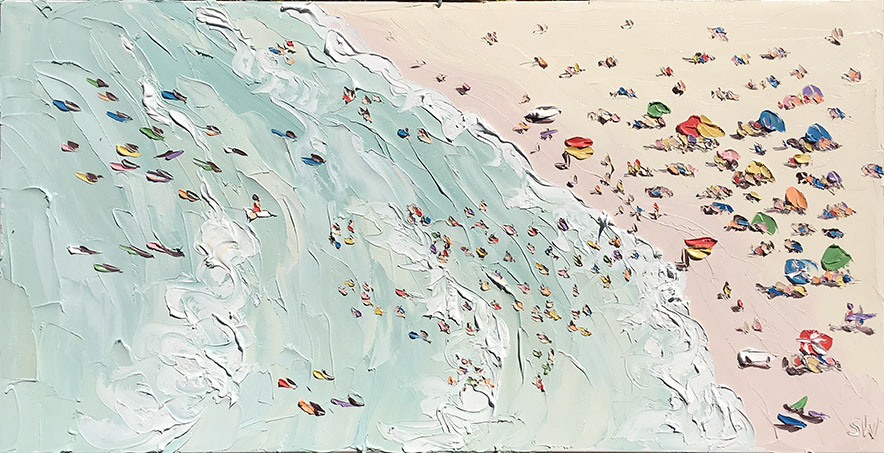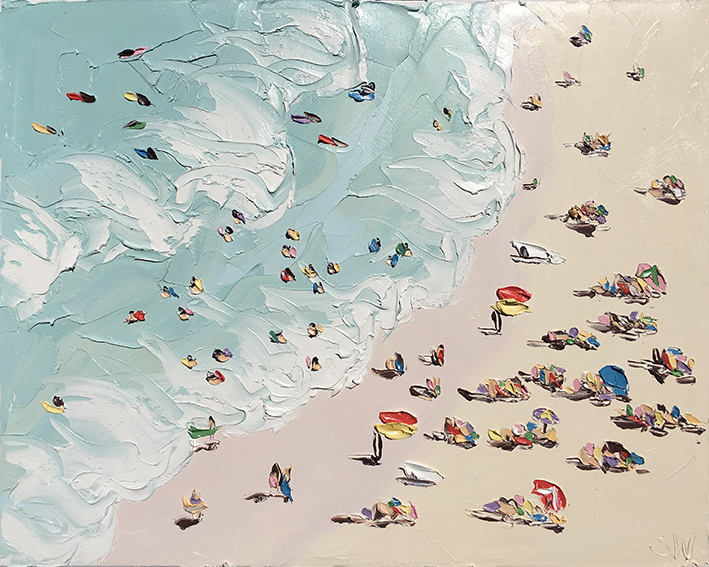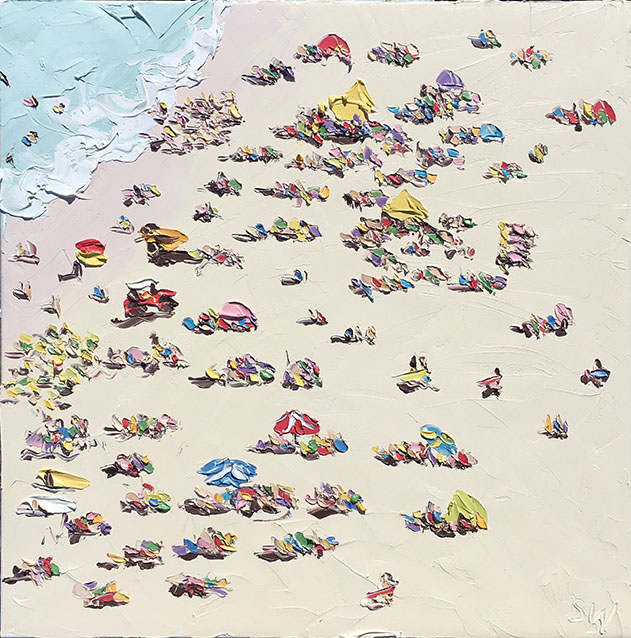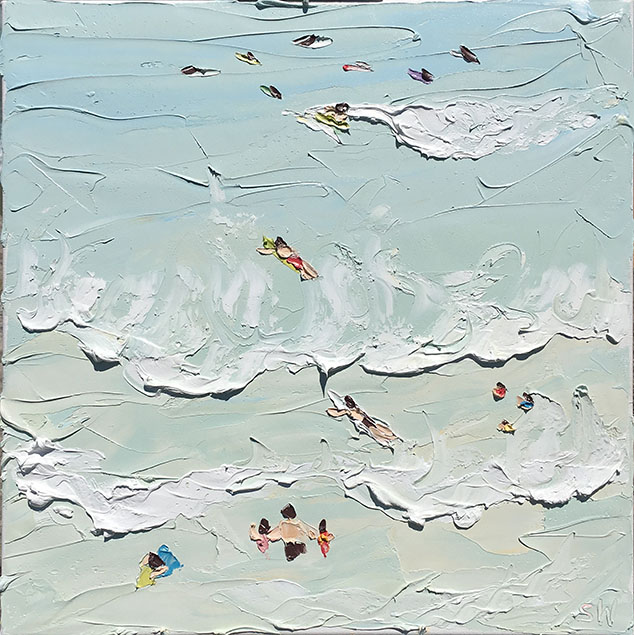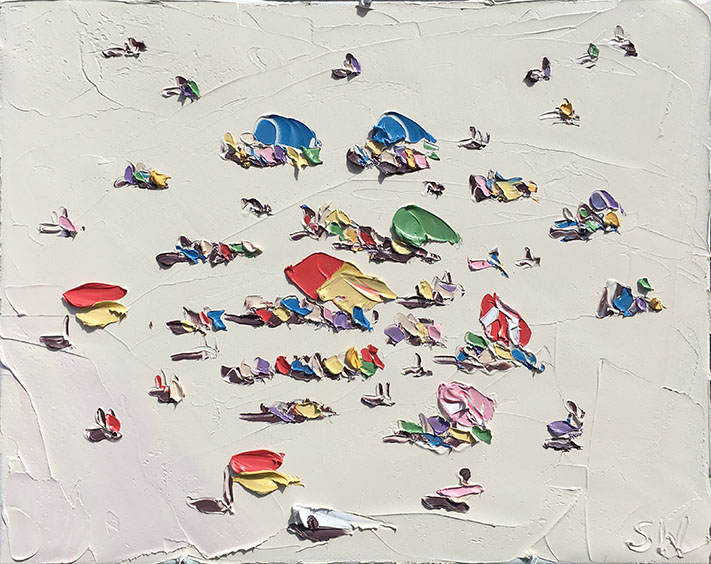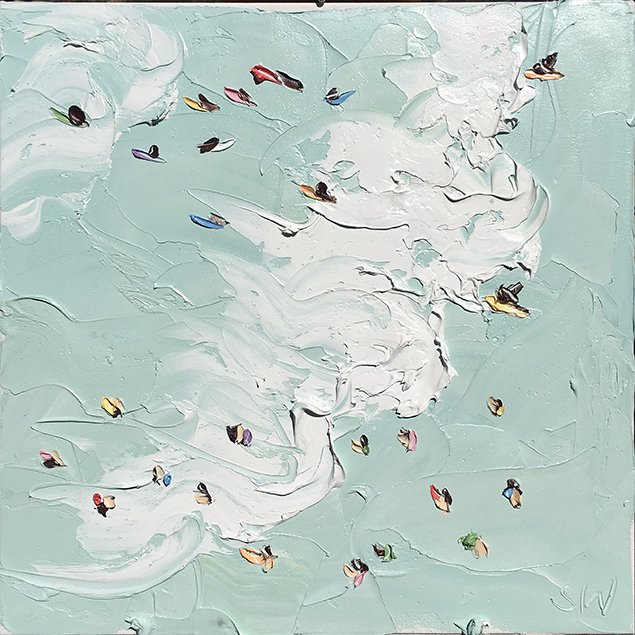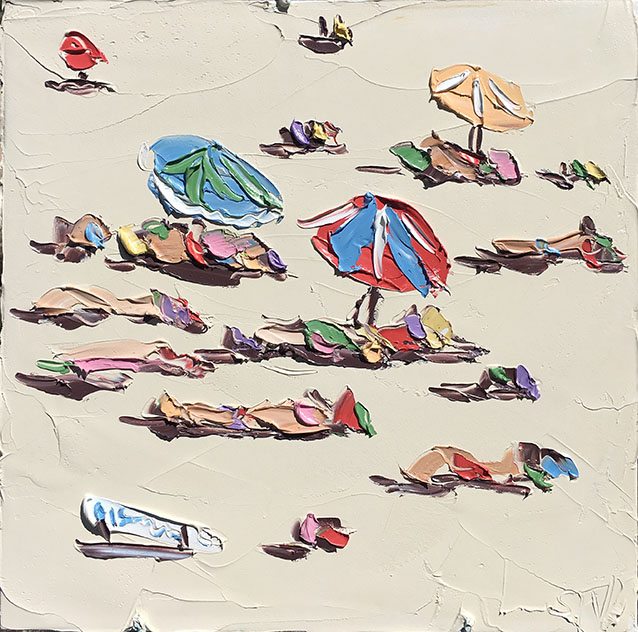Sally West: The Bird of Song with Claws of Paint
'I usually have strange encounters with animals. Of all kinds. I have encountered blue tongue lizards, snakes, bugs I could not name. Birds have often landed on my palette and then flown off with big clumps of paint on their feet. I have always wondered where they left their mark afterwards with all that paint.'
It is hard not to take this comment as self-referential, because Sally West is not unlike the birds she describes: her most famous paintings capture seasides from an all-seeing height, with clumps of paint marking beachgoers and other earthly shadows as they sweep across the foaming waves. West relies for her aesthetic effects on heavy impasto (this means her works are textured with the application of thick lashes of oil paint) and on her considered use of colour, juxtaposing strong, almost screaming, flakes of pigment to broad shores of muted shade. In these paintings people and objects become patterns, and through repetition these shapes and forms acquire a wondrous touch. Of course, to the most facetious and prosaic amongst us these paintings may be evocative of rock climbing walls or fields cluttered with nailed and popped balloons. Tush, tush. Not to my readership.
In her beach studies, West has found a niche, and in it her direction, which she has followed with devotion. Nonetheless, it has been a long journey, and it started in West Wyalong, Central NSW, where she was raised on a farm.
'My strongest memories of childhood are those on the farm in the Outback of Australia. The heat, the horses, the sheep, the flies. We spent long days mustering sheep in that unforgettable, blistering heat.'
At the age of seven, in the year 1976, the young West won the Australia Post Art Colouring-In Competition. Part of her talent had now been unveiled, and the thrill of its spectre would spark West more and more as years went by.
'Artistically, my aunt was a great influence. When I was little she used to give me space to paint and would hang all my paintings to dry in her sunroom.'
One of these paintings is a self-portrait she made at the age of twelve. The portrait still hangs in the farmhouse of her childhood, in the very bedroom she grew up in.
'Apart from that, and some drawing in the dirt with sticks, I had very little exposure to real art until I was shipped off to boarding school in the city (Sydney’s East, to be precise) when I was twelve years old. There I was taken to art galleries and museums, and received primary tuition in the arts. I was a shy kid, and a couple of teachers saw my love for art and encouraged me. They also encouraged my parents to take an interest in what I was doing in the art rooms. My world opened up.'
From 1983 to 1989, she attended this boarding school, and afterwards she completed a secretarial course. Although she then worked full-time as a legal secretary, she also undertook training in drawing and painting at Eastern Suburbs evening college. In 1992, she went backpacking through Europe for twelve months, and her first destination was perhaps the most enchanting of all: Florence. She says her interest in art flourished when she attended the university there. West returned to Australia to begin her studies for a Bachelor of Visual Communications at KVB College of Visual Communications in North Sydney:
'I was around about twenty and was sharing a house with about a million other students. I remember doing charcoal portraits for tourists at Circular Quay at that time. This was challenging to me on multiple levels - first, I needed to produce some sort of semblance to the sitter, both in terms of character and physicality, in a short time; secondly, I have always been shy, back then debilitatingly so. It really forced me to step out of my comfort zone, to talk to people and interact with strangers, and that…that was extremely beneficial to me in so many ways.'
In that same year she would sell her first painting at the Gould Street Gallery in Bondi.
'I had been over the moon that the gallery actually took some of my work to display. But when they called to tell me that I had sold a painting - I think it was for about $200 - I felt like I had won the lotto, and celebrated with my friends for days and days. It was really exciting.'
In the years that followed she would pay visits to a variety of countries in Asia, setting out to learn from their artistic traditions. 'My travels to Vietnam, Thailand, India and Nepal introduced me to unique colour palettes that I often draw on when mixing colour.'
These sojourns allowed her to rethink and develop her use of colour further, into something unique. But what about her impasto technique?
'Over time the brushes became stiff and it was a bit like working with stumps. I found an old palette knife lying around and figured it would tide me over until I got new brushes. I have rarely ever used a brush since and my application of paint has become thicker, simply because it’s just so much easier to load paint onto a palette knife.'
These palette knifes are the claws to West’s bird of painterly song. West and her knifes are as inseparable as Todd and his razors; they are crucial extensions of her arm. They dictate the topography of her landscapes, which are invariably convulsive, as if in tsunamic upheaval. As such one may well presume disaster is constantly heading to her seemingly carefree beach scenes. Really, some more should be said about these beach studies, as any of them is instantly recognisable as West’s own work: even though they are literally impressionistic, they are not usually categorised with the works of other plein air impressionists, in part because there is no one who paints them quite the same way she does. Instead, I wonder whether it would be tenuous to link them with the surrealist work of Yves Tanguy.
Tanguy’s canvases are at times minimalistic, but usually densely populated with biomorphic shapes. These forms, blobs of paint that evoke associations, float; blurred backgrounds undulate; and rock formations which initially seem too abstract for interpretation turn out to be identifiable as distinct beings and objects. Here there is some overlap with the flakes that populate Sally West’s beach and (upcoming) snow studies; they, too, are abstract and otherworldly in their contortion and simplification. West explains why she does not tire of these studies, 'Each day at the beach is a new day. There is never a day the same. Sometimes there is hardly anyone on the beach, other days it is packed. Some days there are big swells and currents, other days it’s very calm in the water. I love studying the changing moods of the beach, and I am there to record it all.'
Hollywood-based photographer Gray Malin’s series À La Plage, À La Piscine (‘At The Beach, At The Pool’) comes to mind too. He takes aerial pictures of colourful beaches, allegedly ‘capturing the spirit of summer’.
'A lot of people ask me if I have painted from photos taken with a drone. I haven’t. I paint aerial scenes from headlands, but I know plenty of photographers who use drones to take pictures,' she says, dismissing the idea that she uses photography for her paintings in any fundamental way. She has predominantly engaged herself with the works of painters: Basquiat, Gauguin , Matisse, Picasso, Charles Blackman, John Olsen, Brett Whiteley.
Sometimes West packs up her palette paws, waves bye-bye to the waves, the surfers, the swimmers, and descends from her high rock. She then spends her efforts at (rather accomplished) flower studies, and sometimes portraits, such as the likeness she painted of ‘maverick politician’ Bill Heffernan.
Farmer Bill
'A family friend of mine who was a farmer suggested I paint Bill Heffernan. They had grown up on neighbouring properties. So when I was on the way back to Sydney, having been out to visit my father on the farm that I grew up on, I drove up to Bill’s farmhouse.'
Infamously, Heffernan read out an anonymous letter (reportedly penned by a senior public servant) which said, 'God help the animals on your farm if you run the farm like you run the Senate committee.' West, however, notes 'what an amazing connection he has to that land.'
'Bill grew up on this property and had never lived anywhere else. When I arrived at the farmhouse I was met by his wife who said that Bill had gone to the doctor as he had cut his hand badly and needed stitches. He soon arrived with a huge bandage on his hand, and I realised how very stoic he really was when he casually explained "it’s nothing, it’ll be right.” He invited me to sit in the lounge room with him where we talked as I made numerous sketches of him. I learnt about Bill’s family, childhood, farming practice and we even briefly touched on politics. It was a very enjoyable meeting, but as I drove back to Sydney I was beginning to feel restless. I felt I needed to begin painting the portrait back in my studio immediately. I assume these are standard feelings for any artist, but I had such anxious thoughts about doing a good job. I worked on the portrait for about a week - a week full of sleepless nights. You see, I liked Bill, I thought he was a good man. Would I ever do him justice?'
West points out that the background in the painting is from a photograph she took from a high point of the landscape that overlooked his property. 'You can see his home in the painting above the right shoulder.'
Another notable sitter was actor Ben Mendelsohn. In this portrait Mendelsohn’s hair is a curly bush of thorns, and his face an apparent collection of coloured glass shards, a mismatched mosaic of charm.
Ben Mendelsohn
'I had always been a big fan of Ben Mendelsohn, and at the time I was living in a small coastal village on the mid north coast of NSW Australia. It was an incredibly beautiful place and Ben was there filming a movie along with Naomi Watts and other stars. I would see him come and go from the local general store and felt totally in awe of his presence. I eventually asked the shop owners to deliver a letter to him the next time he came in. It was a letter asking him to sit for me in my studio.' Not much later West got a phone call from Mendelsohn, as he was happy to organise a time. 'He came to the studio for about three hours. It was an extremely pleasant encounter. We talked a lot about his career and his life, and we discovered that we had virtually been neighbours in Bondi back in the ‘90s. Small world, to be sure! Like Bill Heffernan, he was a man with integrity and strong beliefs, and it was a joy meeting both of them.'
Whereas in her beach studies Sally eyes the crowd from a safe distance (like the shy schoolgirl of yore), with her portraits she gets close and intimate with her subjects. When I ask her whether there might be a link between the ‘debilitating shyness’ she had in the past and the fact her most famous paintings depict people far-off, she answers very candidly:
'I do find portrait sittings more challenging than painting people from a distance. The up-close personal nature of painting someone and having to get to know them and interact on a personal level is always harder and still somewhat out of my comfort zone.'
Despite this, West clearly relishes capturing her sitters on a canvas. Her portraits are still of varied quality and merit, but she has shown me a number of portraits executed in different manners of painting, and they do attest to her appetite for artistic exploration. And this adventurous mindset will, undoubtely, also make her an accomplished player in the field of portraiture.
At present West is again packing her car full of supplies. She will soon be off to a new destination. Her husband says her eyes glaze over once she starts painting, as though Sally locks herself up behind the bars of her own blue eyes. Stirring within her are water, sand, sea, and breeze.
In times of relative calamity (such as these), people long for complementary calm. And whatever trouble the art critic may conjure up by means of allegory or obscurantist mumbo jumbo, he cannot ultimately distract from the essentially still and reassuring nature of these paintings. Her splendid song of shade and shore will be heard, only because people want to hear her song. It has thus far already been heard in exhibitions in London, Paris, New York and Hong Kong. Her artistic voice is evolving and reaching new heights every working day. The wind blows west; this bird will fly.
For more information on Sally West's work visit her website here.
